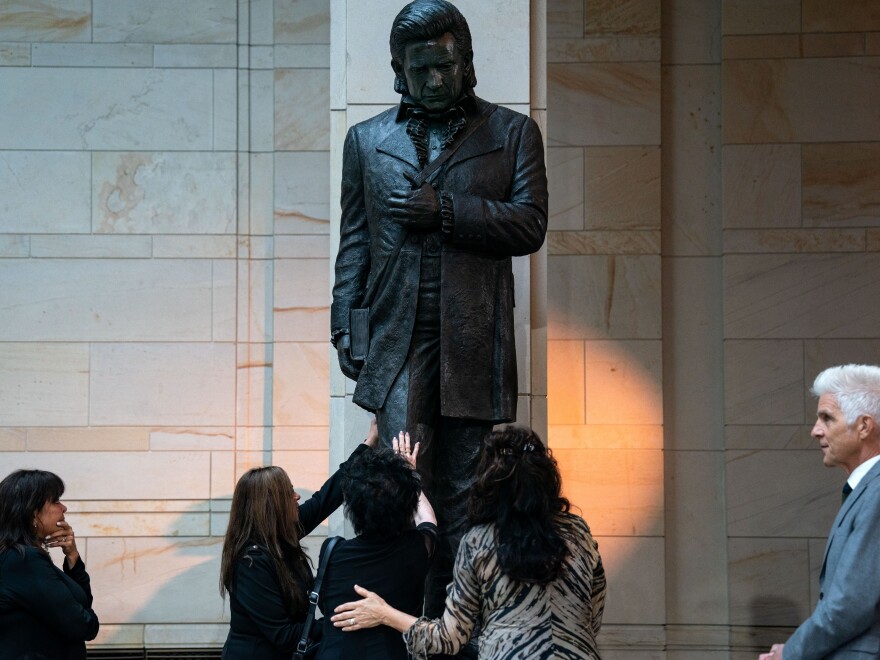When tourists visit the U.S. Capitol, they’ll now be treated to seeing a statue of the legendary musician Johnny Cash.
Cash is the first musician ever to be honored with a statue as part of the Statuary Hall collection, which includes two statues donated by each state to honor notable figures in state history.
“Johnny Cash is the perfect person to be honored in that way. He was a man who embodied the American spirit in a way that few could,” said House Speaker Mike Johnson at the unveiling ceremony on Tuesday.
Johnny Cash, born in Kingsland, Arkansas in 1932 during the Great Depression, is most often associated with country music, but his body of work went beyond any one genre.
“At different times, he was country blues, rock and roll and gospel,” said House Democratic Leader Hakeem Jeffries. “He was a trailblazing, transformational and trendsetting figure.”
The bronze statue shows Cash with a guitar slung across his back and a bible in his hand, a symbol of his enduring faith.
“He was a man of powerful Christian faith, but with the mind of a mystic, who respected all individual paths to God and all the mysteries of the universe,” said his daughter, Roseanne Cash, at the ceremony. She was one of 100 Cash family members at the event.
“Dad was a man of wonderful contradictions,” she said. “He opposed the war in Vietnam, and he went to perform for the troops. He performed for Nixon at the White House and respectfully declined to sing one of the songs the president requested, which criticized welfare recipients because dad thought it denigrated the poor.”

Kent Nishimura/Getty Images / Getty Images North America
/
Getty Images North America
Joanne Cash, sister of the singer Johnny Cash, reached out to touch the statue of her late brother at the unveiling in the U.S. Capitol on Tuesday. Rosanne Cash, daughter of Johnny Cash, told the audience at the event that her aunt had lost her sight and asked that she have the opportunity to feel the statue to appreciate it.
Johnny Cash historian Mark Stielper told NPR Cash used his music as a vehicle for delivering messages.
“He sang at prisons. He was an early pioneer in singing and talking about the injustices done to the Native Americans in this country,” he said,” said Stielper, who was friends with Cash for twenty years.
“He put out full albums about this on his national television show that he had in 1969 through 1971. He got up there and he sang of the poor and the beaten down, living in the hopeless, hungry side of town. Variety shows were not designed for people to be in your face like that with these messages. They weren’t supposed to make us wonder whether we could be better and even more importantly, make us want to be better. And that’s what his message was for fifty years.”
Journey to Capitol Hill
The process of getting a statue of the Man in Black to Capitol Hill has been nearly five years in the making.
The Arkansas legislature voted in 2019 to replace the state’s two statues at the time, Uriah Rose and Sen. James Clarke.
Asa Hutchinson, the governor at the time, pushed for the change.
“It’s been over 100 years since the statutes were replaced for Arkansas, and our state has changed. James Clark was a segregationist. You had Uriah Rhodes that was a Confederate sympathizer,” Hutchinson told NPR. “They do not reflect what our state represents today.”
Statues of civil rights leader Daisy Bates and Johnny Cash were chosen to replace the statues representing Arkansas.
“Whenever you look who reflects Arkansas and who tells the story of Arkansas’s progress, one should be in the civil rights era and that’s Daisy Bates, who’s an icon that guided the Little Rock Nine and the desegregation of Central High School. What an incredible story of courage and progress for our state,” Hutchinson said. “And then, of course, the other one is Johnny Cash. His songs come from the dirt of the flatland of Arkansas. It’s a story about struggle and his progress in life and his fighting for the underdog.”
For the last decade, there have been calls to remove segregationist symbols from the U.S. Capitol.
States are able to go through a process, like Arkansas did, to change which statue they are donating to the Capitol.
In 2022, Florida replaced a previous statue of a Confederate general with Mary McLeod Bethune, becoming the first Black person to have a state-commissioned statue in the Statuary Hall.
There remains more than a handful of statues that have ties to the Confederacy — including its president, Jefferson Davis.
Copyright 2024 NPR
Source link : http://www.bing.com/news/apiclick.aspx?ref=FexRss&aid=&tid=66f366095afd4064ab8410d6c4cf9a8a&url=https%3A%2F%2Fwww.mainepublic.org%2Fnpr-news%2F2024-09-24%2Fus-capitol-statue-of-johnny-cash-depicts-arkansas-history-and-progress&c=10358020536448459784&mkt=en-us
Author :
Publish date : 2024-09-24 14:02:00
Copyright for syndicated content belongs to the linked Source.
